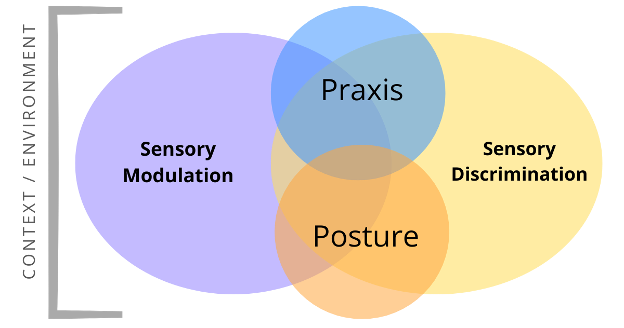Embracing Neurodiversity: Understanding Sensory Subtypes in a New Light (PART 1)

It’s essential to approach the topic of sensory integration and processing with a mindset that honors the diversity of human experiences. This means steering clear of pathologizing language.
Exploring Sensory Subtypes
Differences in sensory integration and processing show up in a few common patterns. These patterns are discussed in different configurations and with different language depending on the frame of reference you are using or the research lab you follow. Additionally, these conceptualizations will continue to be updated as ongoing research provides more data. STAR Institute identifies several sensory subtypes, each representing distinct sensory processing characteristics. These include sensory modulation differences, sensory discrimination differences, and posture and praxis differences. Understanding these subtypes helps tailor interventions to support individuals in navigating their sensory environments effectively.

For example, individuals with heightened sensory responsivity may benefit from accommodations that reduce the intensity of sensory inputs – like noise reduction earplugs, sunglasses, a hat or a hood, or gloves. Those with lowered sensory responsivity may need to move while they work or learn, background music, brighter lighting, or dynamic seating options.
The Importance of Individualized Support
While subtyping provides valuable insights, it's essential to remember that everyone’s sensory experience is unique. The complexity of human experience means that sensory patterns can overlap and change, requiring a personalized approach to support. Occupational therapists and other professionals can work with individuals to develop sensory lifestyles that meet their specific needs, enhancing their ability to thrive in various environments.
Rethinking Sensory Responsivity – A Note on Language
When discussing sensory responsivity we can use language that starts in a neutral space and reflects the strengths and challenges of these experiences. Traditionally, terms like "sensory over-responsivity" have been used, but they can carry a pathologizing connotation. Instead, we might consider using "heightened sensory responsivity," which acknowledges that this trait can be both a strength and a challenge. For instance, individuals with heightened sensory responsivity might excel as super tasters or ballerinas, where their acute sensory awareness enhances their abilities.
Similarly, "sensory under-responsivity" might be reframed as "lowered sensory responsivity," highlighting a different pattern of sensory processing. Lowered sensory responsivity, or hypo-responsivity, can be advantageous in various occupations where individuals may benefit from a reduced sensitivity to sensory stimuli. Not everything needs fixing! For instance, individuals with lowered sensory responsivity might excel in roles that require working in environments with high levels of noise or activity, such as construction sites or manufacturing plants, where they may not be as easily overwhelmed by the surrounding noise and movement. Additionally, occupations in emergency services, such as firefighting or paramedic work, could benefit from individuals with lowered sensory responsivity, as they may remain calm and focused in high-pressure situations with intense sensory input. Individuals with lowered sensory responsivity might find strengths in occupations that involve repetitive tasks or require sustained attention over long periods, such as assembly line work or data entry, where they can remain engaged without becoming easily distracted by external stimuli.
This perspective aligns with the STAR Frame of Reference.
Sensory Subtypes – Modulation Differences
Sensory modulation refers to the way our brains process and respond to sensory information from our environment and our own bodies. It encompasses how the "size" or intensity of sensory signals is maintained as they travel from one neuron to another, primarily (we think) at the synapses. This modulation is crucial because it determines how we perceive and react to various sensory inputs, such as sounds, sights, and touch.
When sensory signals are transmitted through the nervous system, their amplitude—essentially their strength or intensity—can be preserved or altered. This modulation process allows us to focus on important stimuli while filtering out distractions. However, for some individuals, this process can be disrupted, leading to sensory modulation differences.
Heightened and Lowered Sensory Responsivity
Most of the research in sensory integration and processing differences focuses on sensory over-responsivity—sometimes called reactivity.
Sensory Over-Responsivity (SOR): This describes when a person’s brain-and-body has an exaggerated response to sensory stimuli. For example, someone with SOR might find everyday sounds overwhelmingly loud or feel distressed (or even hurt) by certain textures.
Under responsivity is the second most researched phenomena.
Sensory Under-Responsivity (SUR): SUR describes a muted or diminished response to sensory input. People with SUR in one or more systems might not notice or react to stimuli that would benefit from a response.
Sensory Overwhelm: Lack of Gating
In this scenario, individuals are bombarded by sensory input all the time, with no effective means to discern what is important from what is not. This can manifest as a continuous barrage of sensations where everything feels equally intense and significant, leading to a sense of overwhelming noise and confusion.
In this state, individuals may struggle to identify salient (relevant) sensations in their environment, making it difficult to focus on specific stimuli. For example, a person might find it challenging to engage in conversation in a crowded room because all the sounds—voices, music, background noise—blend together into an indistinguishable cacophony.
The Neurophysiology of Sensory Modulation
Sensory modulation differences are not simply opposite ends of a spectrum; they involve distinct neurophysiological processes. Research suggests that sensory modulation occurs at synapses, where signals are transmitted between neurons. However, there are also downstream influences that can impact how these signals are processed.
For example, some researchers believe that alpha waves—brain waves associated with relaxed alertness—may play a role in sensory modulation. In cases of SUR, these alpha waves might "mute" certain sensory signals, making them less noticeable to the individual. This means that the brain may not fully register all the sensory information it receives, leading to a lack of response.
The Complexity of Sensory Modulation
Understanding sensory modulation differences is a nuanced endeavor. The interplay of various sensory systems within the nervous system means that different systems may have different mechanisms for SUR and SOR. For instance, the way visual information is processed may differ from how auditory or tactile information is handled.
Moreover, the field of neuroscience is continually evolving. Our understanding of sensory processing and modulation is still developing, and new discoveries are made regularly. This area of research is often described as a "final frontier," with ongoing debates and shifts in understanding. Therefore, it is essential to approach sensory modulation differences with an open mind, recognizing that they are not binary or linear but involve a complex array of factors.
TLDR:
Sensory modulation is a critical aspect of how we interact with the world around us. As research continues to advance, we can expect our knowledge of sensory processing to grow, leading to more effective strategies for understanding and addressing sensory modulation differences.
